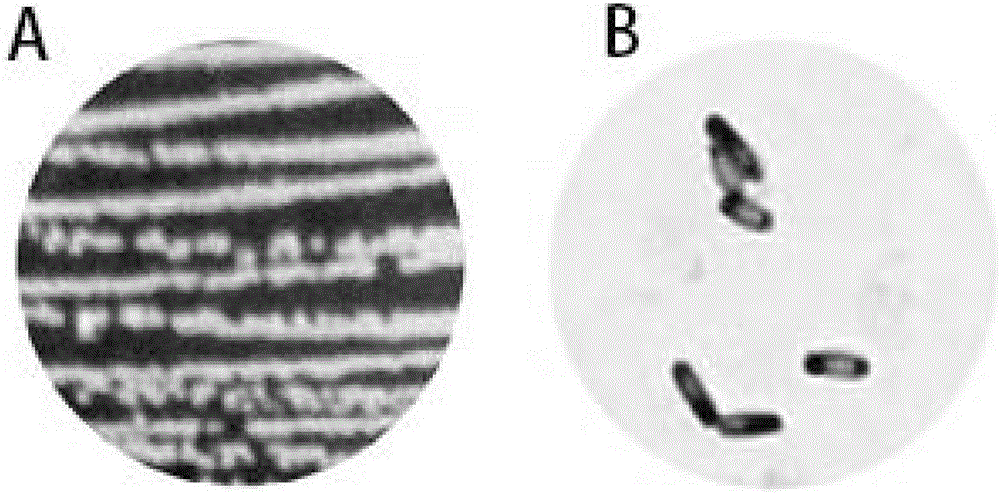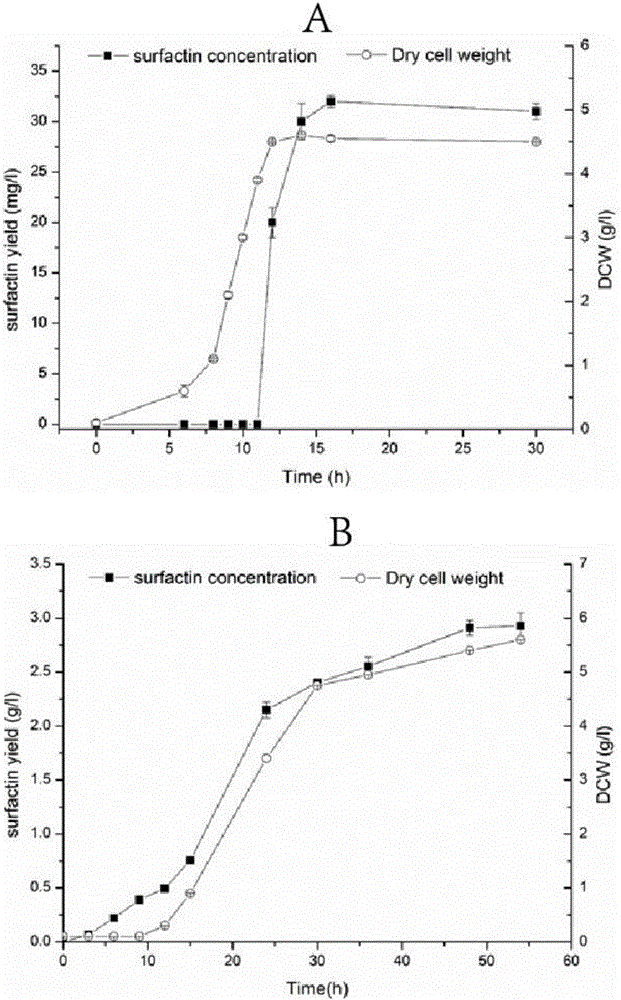Method for producing surfactin by applying bacillus amyloliquefaciens
A technology of amyloliquefaciens and bacilli, which is applied in the field of industrial microorganisms, can solve the problems of high production cost and commercial production of biosurfactant, and achieve the effect of avoiding product feedback inhibition and strong product tolerance
- Summary
- Abstract
- Description
- Claims
- Application Information
AI Technical Summary
Problems solved by technology
Method used
Image
Examples
Embodiment 1
[0035] Example 1 strain screening
[0036]Collect samples from Chinese liquor brewing high-temperature Daqu, take 5g samples and dissolve them in 10ml of 1% by mass sodium chloride solution, vortex and mix well, draw 1mL and inoculate them into the activation culture medium, at a temperature of 50-60°C, 200rpm Activate for 24-36 hours under the condition of rotating speed to make mature activated bacterial liquid.
[0037] Take the mature activated bacteria solution, add 1% sodium chloride solution by mass percentage to dilute. Choose a dilution gradient of 10 -2 -10 -6 The dilutions were sequentially spread on solid medium plates. Cultivate for 48-72 hours at a temperature of 30°C and a humidity of 40%-60%; a large number of single colonies are obtained. After the obtained single colony was inoculated into the nutrient medium for fermentation and culture, the content of biosurfactin in the fermentation liquid was detected, and finally a pure culture with high biosurfactin...
Embodiment 2
[0038] The assay method of embodiment 2 biosurfactins
[0039] Extraction of biosurfactin: centrifuge the fermentation broth at 8000rpm at 4°C for 10min. The fermentation supernatant was adjusted to pH 2.0 with 6mol / L hydrochloric acid, and placed in a refrigerator at 4°C for 2 hours. Then, centrifuge at 12000 rpm at 4°C for 30 min to obtain a precipitate. The crude product of biosurfactin was obtained after the precipitate was extracted with methanol.
[0040] Determination method of biosurfactin in fermentation broth: adopt ultra-high performance liquid chromatography to accurately quantify biosurfactin. A waters BEH C18 chromatographic column was used, the mobile phases were (A) 0.1% formic acid aqueous solution and (B) HPLC grade methanol, and the elution conditions were 30%-70% methanol for 5 min and 70%-100% methanol for 1 min. Samples were detected at 210 nm using a diode array detector. After the obtained chromatographic peaks were integrated, the interpolation met...
Embodiment 3
[0041] Example 3 The strains screened in Example 1 were identified.
[0042] The bacterial strain numbered MT45 obtained in Example 1 was subjected to strain identification.
[0043] The Bacillus amyloliquefaciens MT45 strain formed round and translucent colonies on the solid plate medium; the surface of the colonies was smooth and wrinkled, and no biofilm represented by wrinkled colonies was formed; the center of the colonies was slightly raised. Under the microscope, the cells were rod-shaped, spore-forming, and Gram staining was positive ( figure 1 ).
[0044] The strain 16r rRNA gene sequence was sequenced (SEQ ID NO.1), compared with the database, and phylogenetic tree analysis was carried out to determine that MT45 was Bacillus amyloliquefaciens (Bacillus amyloliquefaciens) ( figure 2 ).
[0045] Bacillus amyloliquefaciens MT45 was deposited on June 6, 2016 in the General Microbiology Center of China Committee for the Collection of Microorganisms, with the preservati...
PUM
 Login to View More
Login to View More Abstract
Description
Claims
Application Information
 Login to View More
Login to View More - R&D
- Intellectual Property
- Life Sciences
- Materials
- Tech Scout
- Unparalleled Data Quality
- Higher Quality Content
- 60% Fewer Hallucinations
Browse by: Latest US Patents, China's latest patents, Technical Efficacy Thesaurus, Application Domain, Technology Topic, Popular Technical Reports.
© 2025 PatSnap. All rights reserved.Legal|Privacy policy|Modern Slavery Act Transparency Statement|Sitemap|About US| Contact US: help@patsnap.com



